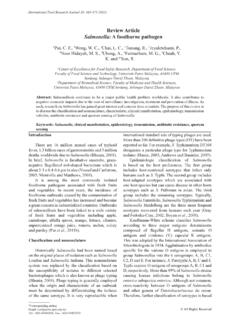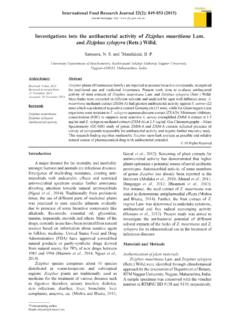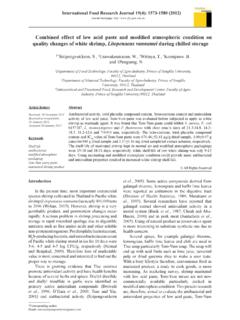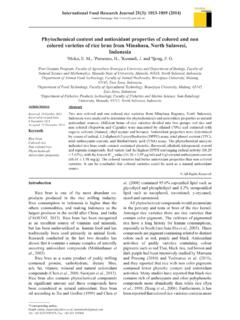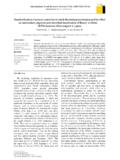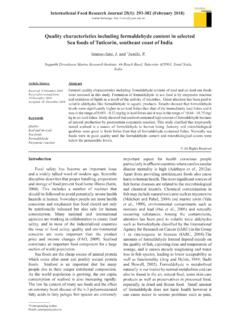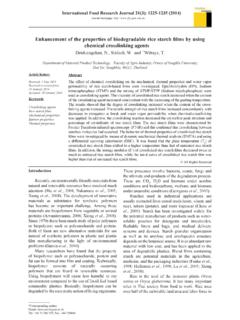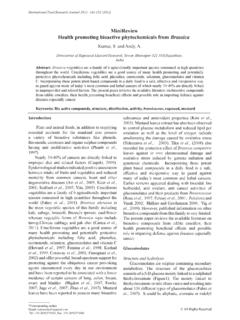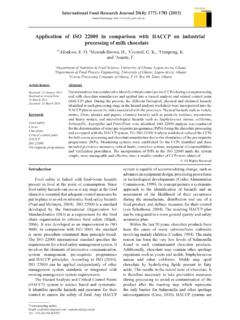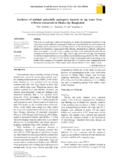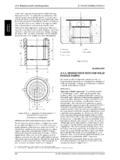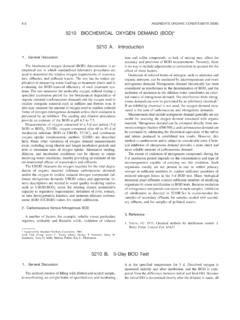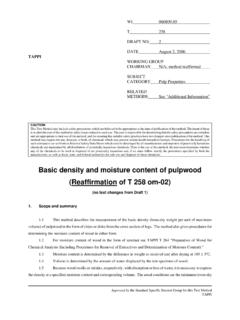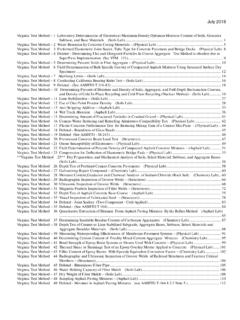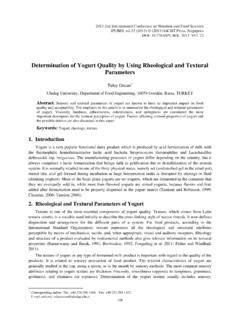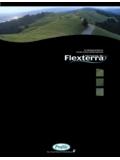Transcription of Assessment of different methods for determining …
1 All Rights Reserved*Corresponding author. Email: +55 55 32208254 International Food Research Journal 22(1): 356-362 (2015)Journal homepage: hn, , 1 Fontoura, , 2 Kempka, , 3 Demiate, , 4 Kubota, and 4*Prestes, 1 Academy of advanced level course in Food Technology, Federal University of Santa Maria (UFSM), Santa Maria, RS, Brazil2 Department of Food Engineering, State University of Santa Catarina (UDESC), Pinhalzinho, SC, Brazil3 Universidade Estadual de Ponta Grossa (UEPG), Postgraduate program in Science and Food Technology (PPGCTA), Ponta Grossa, PR, Brazil4*Department of Technology and Food Science, Federal University of Santa Maria, Santa Maria, RS, BrazilAssessment of different methods for determining the capacity of water absorption of ingredients and additives used in the meat industry AbstractWater absorption capacity (WAC)
2 Basically consists in the method for quantify the water retained by the pelleted material in the centrifuge tube after adding water or an aqueous solution to a material. This property is economically important because it affects the yield and quality of meat products (cooked hams, sausages and mortadellas). The aim of this study was to evaluate three methods for determining WAC and to compare the values obtained for thirteen different ingredients (proteins and polysaccharides) used in the meat industry. There was a significant difference (p < ) in the WAC values (%) obtained for the three methods . Only the cassava starch showed similar % WAC results, regardless of the evaluation method used. The highest percentages of WAC were obtained for a sample of modified starch with up to , and also for guar gum and for soy protein isolate.
3 Method 1 (addition of water) showed results that were most consistent with the literature data and higher WAC values for seven of the thirteen samples tested, thus this was the best method. IntroductionWater absorption capacity (WAC) or water holding capacity (WHC) consists of adding water or an aqueous solution to material, followed by centrifugation and quantification of the water retained by the pelleted material in the centrifuge tube (Damoradan et al., 2010).WAC is economically important for the meat-processing industry because the loss of moisture adversely affects the yield and quality of the product (Ord ez et al., 2005). According to Wang et al. (2006) high values of water absorption capacity are important to help maintain the moisture content of products.
4 The use of ingredients with high WAC assists in improving the quality of meat products and the maintenance of appropriate characteristics throughout shelf-life or even when the product is subjected to adverse conditions such as high temperatures and freezing (for example as ready-made dishes or foods that go from freezer to oven). Proteins and polysaccharides are among the ingredients and additives commonly used by the industry. However, there is a gap in the literature regarding studies assessing WAC ingredients and additives, as well as the most appropriate methodology for this Assessment . There is also a need to generate information for industry in order to assist in the choice of ingredients and additives in the development of new formulations of meat products.
5 different methods for evaluating WAC are described in the literature (Barbut, 1996; Tsai et al., 1998; Hedenus et al., 2000; Wang et al., 2006). Wang et al. (2006) reported the methodology developed by Sosulski (1962), which determines the absorption of water in flours by centrifugation and drying in an oven. Tsai et al. (1998) suggest only centrifuging, without the need for drying. Hedenus et al. (2000) suggest two methods to assess the absorption of water; one using isotherms and the other by evaluating the volume before and after swelling. The aim of the present study was to evaluate and compare the WAC of various ingredients and additives used in the meat KeywordsGuar gumModified starchCassava starchSoy proteinCarrageenanArticle historyReceived: 21 March 2014 Received in revised form: 14 June 2014 Accepted: 16 June 2014357K hn et 22(1): 356-362industry using three different methods to determine which ingredient or group had a greater WAC and whether there would be differences between and MethodThe experiments were performed at the Laboratory of Physical Chemistry, Department of Food Science and Technology (DTCA) of the Federal University of Santa Maria (UFSM), Santa Maria (RS), Brazil.
6 The ingredients and additives were divided into two groups (proteins and polysaccharides) and the following were tested: (SIP) soy protein isolate (ADM, S o Paulo, SP); (TSP1) textured soy protein (Doremus, Guarulhos, SP); (TSP2) textured soy protein (Marsul, Montenegro, RS); (CSP) concentrated soy protein (Marsul, Montenegro, RS); (GG) guar gum (Nutract, Chapec , SC); (CAR) kappa-carrageenan (Doremus, Guarulhos, SP); (U8) Ultratex 8 modified starch (National Starch, Jaguar SP); (MS1) Novation 2300/EK 8925 modified starch (National Starch, Jaguar SP); (EMS) Eliane 100 modified starch (National Starch, Jaguar SP); (TMS) Thermetex modified starch (National Starch, Jaguar SP); (MS2) Novation 1900 modified starch (National Starch, Jaguar SP); (CS) cassava starch (Lar, Medianeira, PR) and (U3) Ultratex 3 modified starch (National Starch, Jaguar SP).
7 The pH of all the ingredients and additives was evaluated by electrometric determination according to the official method (AOAC, 1990; IAL, 2005) in water and in saline solution ( ). different solvents were tested to evaluate the differences and effects on the WAC of the ingredients and additives. For the evaluation of WAC, three methods were used to assess which method was more appropriate and/or which would present most consistent results and also which would be most suitable to be used in the meat industry meats where maximum WAC is required. Method 1 consisted of weighing 5 g of sample into each centrifuge tube (Falcon type plastic tubes with capacity of 50 mL) and adding 32 mL of distilled water followed by manual shaking for 1 minute.
8 Immediately afterwards, the tubes were placed at rest for 10 minutes and then centrifuged for 25 minutes at 2,900 g. The supernatant was discarded and the tubes were dried in an oven with circulating air (50 C for 20 minutes with downward inclination of 15 to 20 ). After drying, the tubes were weighed again and the WAC was calculated for each sample as a percentage, taking into consideration the difference in weight, according to Sosulski s modified methodology (1962) cited by Wang et al. (2006).Method 2 consisted of weighing 5 g of sample and adding 8 mL of NaCl solution. This was homogenized and subsequently left to stand in an ice bath for 30 minutes. The material was subsequently centrifuged at 2,900 g for 5 minutes at room temperature.
9 After centrifugation the supernatant was discarded and the tube was reweighed to obtain the weight of saline solution that was retained. The results were expressed as a percentage of the retained solution according to the methodology described by Barbut (1996). Method 3 consisted of weighing 5 g of sample and adding 32 mL NaCl solution. This was homogenized and subsequently left to stand in an ice bath for 30 minutes. The material was subsequently centrifuged at 2,900 g for 5 minutes at room temperature. After centrifugation, the supernatant was discarded and the tube was reweighed to obtain the weight of saline solution that was retained, according to the methodology described by Barbut (1996) with modifications.
10 The experimental design was completely randomized and there were three replicates for each test for each ingredient or additive. The results were submitted to analysis of variance - ANOVA and Tukey s test with a significance level of 95% (p < ) using the Statistica (STATSOFT, INC) software. Results and DiscussionTable 1 shows the results obtained for the pH of the ingredients and additives tested in water (traditional method) and saline solution ( M). There was Table 1. pH results for the evaluated ingredients and additives in water or saline solution)Means with different lowercase letters vertically differ significantly (p < ). Means with capital letters horizontally differ significantly (p < ).
